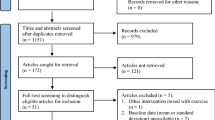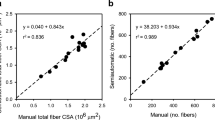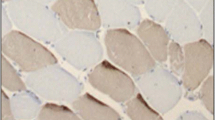Abstract
Presently applied methods to identify and quantify human satellite cells (SCs) give discrepant results. We introduce a new immunofluorescence method that simultaneously monitors two SC markers (NCAM and Pax7), the basal lamina and nuclei. Biopsies from power-lifters, power-lifters using anabolic substances and untrained subjects were re-examined. Significantly different results from those with staining for NCAM and nuclei were observed. There were three subtypes of SCs; NCAM+/Pax7+ (94%), NCAM+/Pax7− (4%) and NCAM−/Pax7+ (1%) but large individual variability existed. The proportion of SCs per nuclei within the basal lamina of myofibres (SC/N) was similar for all groups reflecting a balance between the number of SCs and myonuclei to maintain homeostasis. We emphasise that it is important to quantify both SC/N and the number of SCs per fibre. Our multiple marker method is more reliable for SC identification and quantification and can be used to evaluate other markers of muscle progenitor cells.









Similar content being viewed by others

References
Allen DL, Roy RR, Edgerton VR (1999) Myonuclear domains in muscle adaptation and disease. Muscle Nerve 22:1350–1360
Bischoff R (1975) Regeneration of single skeletal muscle fibers in vitro. Anat Rec 182:215–235
Buckingham M (2006) Myogenic progenitor cells and skeletal myogenesis in vertebrates. Curr Opin Genet Dev 16:525–532
Buckingham M, Montarras D (2008) Skeletal muscle stem cells. Curr Opin Genet Dev 18:330–336
Cashman NR, Covault J, Wollman RL, Sanes JR (1987) Neural cell adhesion molecule in normal, denervated, and myopathic human muscle. Ann Neurol 21:481–489
Charifi N, Kadi F, Feasson L, Denis C (2003) Effects of endurance training on satellite cell frequency in skeletal muscle of old men. Muscle Nerve 28:87–92
Cooper RN, Butler-Browne GS, Mouly V (2006) Human muscle stem cells. Curr Opin Pharmacol 6:295–300
Crameri RM, Langberg H, Magnusson P, Jensen CH, Schroder HD, Olesen JL, Suetta C, Teisner B, Kjaer M (2004) Changes in satellite cells in human skeletal muscle after a single bout of high intensity exercise. J Physiol 558:333–340
Crameri RM, Aagaard P, Qvortrup K, Langberg H, Olesen J, Kjaer M (2007) Myofibre damage in human skeletal muscle: effects of electrical stimulation vs voluntary contraction. J Physiol 583:365–380
Day K, Shefer G, Richardson JB, Enikolopov G, Yablonka-Reuveni Z (2006) Nestin-GFP reporter expression defines the quiescent state of skeletal muscle satellite cells. Dev Biol 304:246–259
Dreyer HC, Blanco CE, Sattler FR, Schroeder ET, Wiswell RA (2006) Satellite cell numbers in young and older men 24 hours after eccentric exercise. Muscle Nerve 33:242–253
Eriksson A (2006) Strength training and anabolic steroids. The Department of Integrative Medical Biology, Section for Anatomy, Umeå University, Sweden and The Department of Health Science, Section for Medical Science, Luleå University of Technology, Sweden
Eriksson A, Kadi F, Malm C, Thornell LE (2005) Skeletal muscle morphology in power-lifters with and without anabolic steroids. Histochem Cell Biol 124:167–175
Eriksson A, Lindstrom M, Carlsson L, Thornell LE (2006) Hypertrophic muscle fibers with fissures in power-lifters; fiber splitting or defect regeneration? Histochem Cell Biol 126:409–417
Gnocchi VF, White RB, Ono Y, Ellis JA, Zammit PS (2009) Further characterisation of the molecular signature of quiescent and activated mouse muscle satellite cells. PLoS ONE 4:e5205
Gundersen HJ (1986) Stereology of arbitrary particles. A review of unbiased number and size estimators and the presentation of some new ones, in memory of William R. Thompson. J Microsc 143:3–45
Illa I, Leon-Monzon M, Dalakas MC (1992) Regenerating and denervated human muscle fibers and satellite cells express neural cell adhesion molecule recognized by monoclonal antibodies to natural killer cells. Ann Neurol 31:46–52
Irintchev A, Zeschnigk M, Starzinski-Powitz A, Wernig A (1994) Expression pattern of M-cadherin in normal, denervated, and regenerating mouse muscles. Dev Dyn 199:326–337
Ishido M, Uda M, Kasuga N, Masuhara M (2009) The expression patterns of Pax7 in satellite cells during overload-induced rat adult skeletal muscle hypertrophy. Acta Physiol (Oxf) 195:459–469
Kadi F (2000) Adaptation of human skeletal muscle to training and anabolic steroids. Acta Physiol Scand Suppl 646:1–52
Kadi F (2008) Cellular and molecular mechanisms responsible for the action of testosterone on human skeletal muscle. A basis for illegal performance enhancement. Br J Pharmacol 154:522–528
Kadi F, Thornell LE (2000) Concomitant increases in myonuclear and satellite cell content in female trapezius muscle following strength training. Histochem Cell Biol 113:99–103
Kadi F, Eriksson A, Holmner S, Butler-Browne GS, Thornell LE (1999a) Cellular adaptation of the trapezius muscle in strength-trained athletes. Histochem Cell Biol 111:189–195
Kadi F, Eriksson A, Holmner S, Thornell LE (1999b) Effects of anabolic steroids on the muscle cells of strength-trained athletes. Med Sci Sports Exerc 31:1528–1534
Kadi F, Ahlgren C, Waling K, Sundelin G, Thornell LE (2000) The effects of different training programs on the trapezius muscle of women with work-related neck and shoulder myalgia. Acta Neuropathol 100:253–258
Kadi F, Charifi N, Denis C, Lexell J (2004a) Satellite cells and myonuclei in young and elderly women and men. Muscle Nerve 29:120–127
Kadi F, Schjerling P, Andersen LL, Charifi N, Madsen JL, Christensen LR, Andersen JL (2004b) The effects of heavy resistance training and detraining on satellite cells in human skeletal muscles. J Physiol 558:1005–1012
Kadi F, Charifi N, Henriksson J (2006) The number of satellite cells in slow and fast fibres from human vastus lateralis muscle. Histochem Cell Biol 126:83–87
Kuang S, Rudnicki MA (2008) The emerging biology of satellite cells and their therapeutic potential. Trends Mol Med 14:82–91
Kuang S, Charge SB, Seale P, Huh M, Rudnicki MA (2006) Distinct roles for Pax7 and Pax3 in adult regenerative myogenesis. J Cell Biol 172:103–113
Kuang S, Kuroda K, Le Grand F, Rudnicki MA (2007) Asymmetric self-renewal and commitment of satellite stem cells in muscle. Cell 129:999–1010
Lanier LL, Testi R, Bindl J, Phillips JH (1989) Identity of Leu-19 (CD56) leukocyte differentiation antigen and neural cell adhesion molecule. J Exp Med 169:2233–2238
Lipton BH, Schultz E (1979) Developmental fate of skeletal muscle satellite cells. Science 205:1292–1294
Mackey AL, Esmarck B, Kadi F, Koskinen SO, Kongsgaard M, Sylvestersen A, Hansen JJ, Larsen G, Kjaer M (2007a) Enhanced satellite cell proliferation with resistance training in elderly men and women. Scand J Med Sci Sports 17:34–42
Mackey AL, Kjaer M, Dandanell S, Mikkelsen KH, Holm L, Dossing S, Kadi F, Koskinen SO, Jensen CH, Schroder HD, Langberg H (2007b) The influence of anti-inflammatory medication on exercise-induced myogenic precursor cell responses in humans. J Appl Physiol 103:425–431
Mauro A (1961) Satellite cell of skeletal muscle fibers. J Biophys Biochem Cytol 9:493–495
Mechtersheimer G, Staudter M, Moller P (1992) Expression of the natural killer (NK) cell-associated antigen CD56 (Leu-19), which is identical to the 140-kDa isoform of N-CAM, in neural and skeletal muscle cells and tumors derived therefrom. Ann N Y Acad Sci 650:311–316
Olguin HC, Olwin BB (2004) Pax-7 up-regulation inhibits myogenesis and cell cycle progression in satellite cells: a potential mechanism for self-renewal. Dev Biol 275:375–388
Olsen S, Aagaard P, Kadi F, Tufekovic G, Verney J, Olesen JL, Suetta C, Kjaer M (2006) Creatine supplementation augments the increase in satellite cell and myonuclei number in human skeletal muscle induced by strength training. J Physiol 573:525–534
Oustanina S, Hause G, Braun T (2004) Pax7 directs postnatal renewal and propagation of myogenic satellite cells but not their specification. Embo J 23:3430–3439
Peault B, Rudnicki M, Torrente Y, Cossu G, Tremblay JP, Partridge T, Gussoni E, Kunkel LM, Huard J (2007) Stem and progenitor cells in skeletal muscle development, maintenance, and therapy. Mol Ther 15:867–877
Petrella JK, Kim JS, Cross JM, Kosek DJ, Bamman MM (2006) Efficacy of myonuclear addition may explain differential myofiber growth among resistance-trained young and older men and women. Am J Physiol Endocrinol Metab 291:E937–E946
Petrella JK, Kim JS, Mayhew DL, Cross JM, Bamman MM (2008) Potent myofiber hypertrophy during resistance training in humans is associated with satellite cell-mediated myonuclear addition: a cluster analysis. J Appl Physiol 104:1736–1742
Reimann J, Brimah K, Schroder R, Wernig A, Beauchamp JR, Partridge TA (2004) Pax7 distribution in human skeletal muscle biopsies and myogenic tissue cultures. Cell Tissue Res 315:233–242
Relaix F, Montarras D, Zaffran S, Gayraud-Morel B, Rocancourt D, Tajbakhsh S, Mansouri A, Cumano A, Buckingham M (2006) Pax3 and Pax7 have distinct and overlapping functions in adult muscle progenitor cells. J Cell Biol 172:91–102
Renault V, Rolland E, Thornell LE, Mouly V, Butler-Browne G (2002a) Distribution of satellite cells in the human vastus lateralis muscle during aging. Exp Gerontol 37:1513–1514
Renault V, Thornell LE, Eriksson PO, Butler-Browne G, Mouly V (2002b) Regenerative potential of human skeletal muscle during aging. Aging Cell 1:132–139
Roth SM, Martel GF, Ivey FM, Lemmer JT, Metter EJ, Hurley BF, Rogers MA (2000) Skeletal muscle satellite cell populations in healthy young and older men and women. Anat Rec 260:351–358
Sajko S, Kubinova L, Cvetko E, Kreft M, Wernig A, Erzen I (2004) Frequency of M-cadherin-stained satellite cells declines in human muscles during aging. J Histochem Cytochem 52:179–185
Schmalbruch H, Hellhammer U (1976) The number of satellite cells in normal human muscle. Anat Rec 185:279–287
Schubert W, Zimmermann K, Cramer M, Starzinski-Powitz A (1989) Lymphocyte antigen Leu-19 as a molecular marker of regeneration in human skeletal muscle. Proc Natl Acad Sci U S A 86:307–311
Seale P, Sabourin LA, Girgis-Gabardo A, Mansouri A, Gruss P, Rudnicki MA (2000) Pax7 is required for the specification of myogenic satellite cells. Cell 102:777–786
Shefer G, Yablonka-Reuveni Z (2007) Reflections on lineage potential of skeletal muscle satellite cells: do they sometimes go MAD? Crit Rev Eukaryot Gene Expr 17:13–29
Shefer G, Van de Mark DP, Richardson JB, Yablonka-Reuveni Z (2006) Satellite-cell pool size does matter: defining the myogenic potency of aging skeletal muscle. Dev Biol 294:50–66
Sinha-Hikim I, Roth SM, Lee MI, Bhasin S (2003) Testosterone-induced muscle hypertrophy is associated with an increase in satellite cell number in healthy, young men. Am J Physiol Endocrinol Metab 285:E197–E205
Sinha-Hikim I, Cornford M, Gaytan H, Lee ML, Bhasin S (2006) Effects of testosterone supplementation on skeletal muscle fiber hypertrophy and satellite cells in community-dwelling older men. J Clin Endocrinol Metab 91:3024–3033
Snow MH (1978) An autoradiographic study of satellite cell differentiation into regenerating myotubes following transplantation of muscles in young rats. Cell Tissue Res 186:535–540
Thornell L-E, Eriksson A, Edström L (1983) Intermediate filaments in human myophaties. Dowben RM, Shay JW (eds) Cell and muscle motility, vol 4. Plenum Press, New York, pp 85–136
Thornell LE, Lindstrom M, Renault V, Mouly V, Butler-Browne GS (2003) Satellite cells and training in the elderly. Scand J Med Sci Sports 13:48–55
Verdijk LB, Koopman R, Schaart G, Meijer K, Savelberg HH, van Loon LJ (2007) Satellite cell content is specifically reduced in type II skeletal muscle fibers in the elderly. Am J Physiol Endocrinol Metab 292:E151–E157
Verney J, Kadi F, Charifi N, Feasson L, Saafi MA, Castells J, Piehl-Aulin K, Denis C (2008) Effects of combined lower body endurance and upper body resistance training on the satellite cell pool in elderly subjects. Muscle Nerve 38:1147–1154
Zammit PS (2008) The muscle satellite cell: the story of a cell on the edge. In: Schiaffino S, Partridge T (eds) Skeletal muscle repair and regeneration. Springer, pp 45–64
Zammit PS, Golding JP, Nagata Y, Hudon V, Partridge TA, Beauchamp JR (2004) Muscle satellite cells adopt divergent fates: a mechanism for self-renewal? J Cell Biol 166:347–357
Zammit PS, Partridge TA, Yablonka-Reuveni Z (2006a) The skeletal muscle satellite cell: the stem cell that came in from the cold. J Histochem Cytochem 54:1177–1191
Zammit PS, Relaix F, Nagata Y, Perez Ruiz A, Collins CA, Partridge TA, Beauchamp JR (2006b) Pax7 and myogenic progression in skeletal muscle satellite cells. J Cell Sci 119:1824–1832
Zheng B, Cao B, Crisan M, Sun B, Li G, Logar A, Yap S, Pollett JB, Drowley L, Cassino T, Gharaibeh B, Deasy BM, Huard J, Peault B (2007) Prospective identification of myogenic endothelial cells in human skeletal muscle. Nat Biotechnol 25:1025–1034
Acknowledgments
We wish to thank Mrs. Anna-Karin Olofsson and Margaretha Enerstedt for excellent technical assistance, Asst. profs Peter Anton and Leif Nilsson for statistical support, Ph.D Lena Carlsson and Prof. Fatima Pedrosa Domellöf for valuable comments on the manuscript and Ph.D Anders Eriksson for referring the power-lifter subjects to us. This study was supported by grants from the Association Française contre les Myopathies, MYORES Network of Excellence (contract 511978) of the European Union, the Swedish Research Council (12x3934), the Swedish National Centre for Research in Sports (108/08, 99/09) and the Medical Faculty of Umeå University, Sweden.
Author information
Authors and Affiliations
Corresponding author
Rights and permissions
About this article
Cite this article
Lindström, M., Thornell, LE. New multiple labelling method for improved satellite cell identification in human muscle: application to a cohort of power-lifters and sedentary men. Histochem Cell Biol 132, 141–157 (2009). https://doi.org/10.1007/s00418-009-0606-0
Accepted:
Published:
Issue Date:
DOI: https://doi.org/10.1007/s00418-009-0606-0



